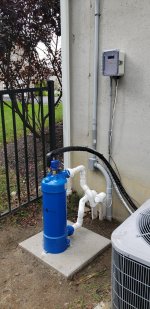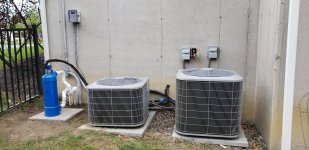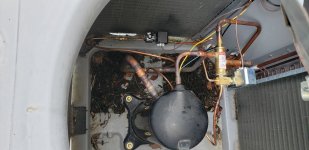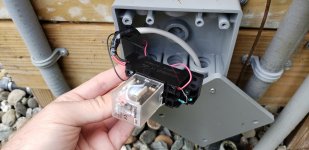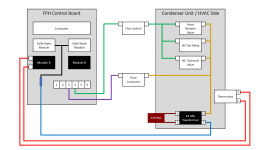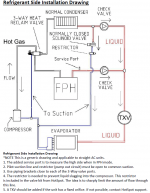I just wanted to share the news, and to offer a note of thanks to @drglanton for sharing so much helpful info, and to @JamesW for coming up with the "solar impersonation" method.
After many false starts, the installation of my Hotspot "Free Pool Heater" (FPH) was finally finished yesterday. The HVAC guy was able to fit the specialty valves into the body of the condenser unit so it looks very clean. It wasn't an especially warm day but still, we cranked the AC in the house down low and watched it fire up. We pretty quickly had warm water flowing into the pool.
Even the guy was amazed that it worked on the first try. The installation is pretty complex and he said that he expected to get it working "eventually" after some amount of troubleshooting. But as soon as I set the thermostat down, the FPH kicked in and everything just started working.
Attached are a few pictures that show the finished installation. The relay is a 24VAC DPDT relay that switches between a 5kΩ resistor (106°F) and a 20kΩ resistor (50°F) feeding my controller's solar input sensor. There's an actuated valve which opens when the FPH is calling for water, and it kicks my pump up to high speed as well.
We're now at the end of the typical AC season here and will be closing the pool any day, but I'm looking forward to an early opening in the spring. Of course I don't yet have any experience using the thing, but if you're considering getting one and have questions about the installation process, I can do my best to answer them!
After many false starts, the installation of my Hotspot "Free Pool Heater" (FPH) was finally finished yesterday. The HVAC guy was able to fit the specialty valves into the body of the condenser unit so it looks very clean. It wasn't an especially warm day but still, we cranked the AC in the house down low and watched it fire up. We pretty quickly had warm water flowing into the pool.
Even the guy was amazed that it worked on the first try. The installation is pretty complex and he said that he expected to get it working "eventually" after some amount of troubleshooting. But as soon as I set the thermostat down, the FPH kicked in and everything just started working.
Attached are a few pictures that show the finished installation. The relay is a 24VAC DPDT relay that switches between a 5kΩ resistor (106°F) and a 20kΩ resistor (50°F) feeding my controller's solar input sensor. There's an actuated valve which opens when the FPH is calling for water, and it kicks my pump up to high speed as well.
We're now at the end of the typical AC season here and will be closing the pool any day, but I'm looking forward to an early opening in the spring. Of course I don't yet have any experience using the thing, but if you're considering getting one and have questions about the installation process, I can do my best to answer them!


